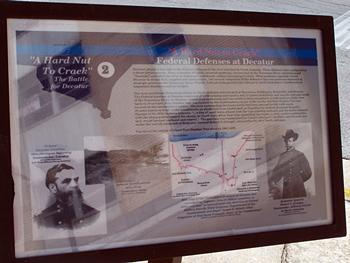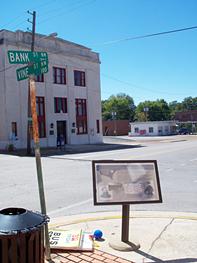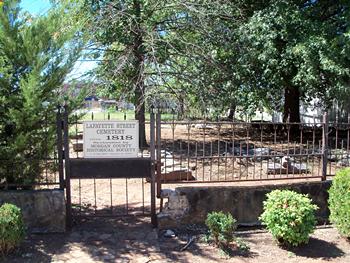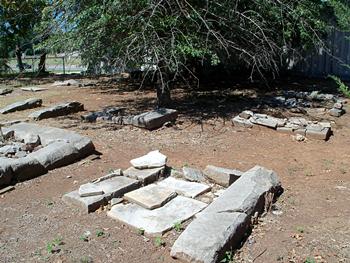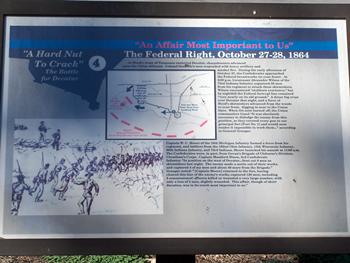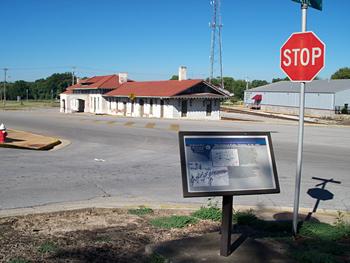|
(Sept. 2010)
Enlarge
Stop 02: "A Hard Nut to Crack" Federal Defenses At Decatur
Decatur played a key role in the Federal defenses of the vital rail lines
in North Alabama. These defenses were configured in a three-tiered system.
First, a number of lightly armored gunboats, constructed on the Tennessee
River and nicknamed ōtinclads,ö patrolled the river to intercept
Confederate raiders attempting to cross. These gunboats regularly visited
Decatur to obtain fuel, supplies and ammunition. The second component of
the defensive line was garrisons stationed at strategic points on the
Tennessee River. Finally, Federal units guarded the railroad in small
stockades or blockhouses at important locations such as bridges. The most
prominent Federal garrisons in North Alabama were located at Stevenson,
Bridgeport, Huntsville, and Decatur. The Federal garrison at Decatur
consisted of 1,800 infantry and cavalry and 17 pieces of artillery, and
was the only post south of the Tennessee River. At Decatur, substantial
earthworks and two artillery forts extended in a 1,600 yard arc from river
bank to river bank. Fort Number One was located on the southwestern corner
of the works, and Fort Number Two was located on the southeastern corner.
The area surrounding the breastworks had been cleared for 800-1,000 yards.
At some points in front of the breastworks an abates had been established,
as described by Orderly Sergeant Daniel L. Thomas of the 68th Indiana
Infantry, "...a line of small trees, placed with the tops pointing
outward, and the limbs trimmed with the sharp points toward the enemy, to
check them when they were assaulting the works, so thatģunder a galling
fire, they would become confused and retreat.ö The garrison was commanded
by Colonel Charles C. Doolittle, and Decatur was under the overall command
of Brigadier General Robert S. Granger, responsible for all of North
Alabama. You are at the center of where Fort Number Two stood 1864-1865
Enlarged Views: Hit Back Button to return |
|
|
(Sept. 2010)
Enlarge
Federal defenses interpretive marker: This is the location of the
center of Fort Number Two |
|
|
(Sept. 2010)
Enlarge
Stop 03: Lafayette Street Cemetery (1818)
Although part of the Decatur Civil War Walking Tour, this stop does not
have an interpretive marker other than the marker on the main gate. This
little plot of land is wedged in between two business district buildings
on a side road off of Bank Street. This is the oldest known city cemetery,
established in 1819 and an original site that survived the Civil War and
the destruction of Decatur |
|
(Sept. 2010)
Enlarge
Lafayette Street cemetery graves |
|
(Sept. 2010)
Enlarge
Stop 04: "An Affair Most Important to Us" The Federal Right, October
27-28, 1864 |
|
(Sept. 2010)
Enlarge
Federal Right interpretive marker. Note the Decatur Depot in the
background which was built in 1895 |
